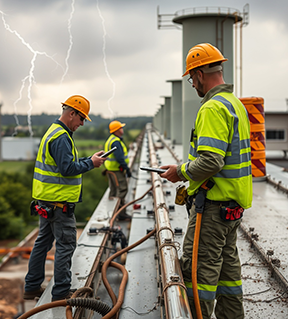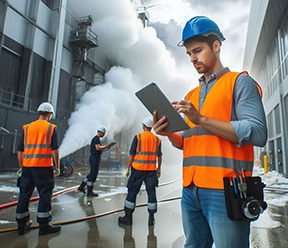Published: June 18, 2015 | Updated: September 18, 2025
Published: June 18, 2015 | Updated: September 18, 2025
Building Resilience: Disaster Preparedness and Maintenance Organization for Facilities
Navigating the Unexpected: Preparing Facilities for Diverse Disasters
 Facility managers and reliability experts dedicate their careers to preventing operational disruptions and mitigating potential hazards. Their focus often centers on equipment malfunctions and property risks, issues typically addressed through diligent preventative and proactive maintenance strategies. However, let's discuss navigating the unexpected and how managers can prepare facilities for diverse disasters.
Facility managers and reliability experts dedicate their careers to preventing operational disruptions and mitigating potential hazards. Their focus often centers on equipment malfunctions and property risks, issues typically addressed through diligent preventative and proactive maintenance strategies. However, let's discuss navigating the unexpected and how managers can prepare facilities for diverse disasters.
The spectrum of potential threats extends far beyond predictable challenges. Natural disasters, with their capacity for widespread devastation, demand a different level of preparedness. What specific types of catastrophes warrant proactive planning for your facility?
The United States' hurricane season serves as a stark reminder of nature's power. Typically, the season runs between June 1 and November 30th. Coastal facility managers must prioritize preparing their properties for the potential impact of tropical weather systems. This extends beyond immediate coastal regions because even facilities located hundreds of miles inland can experience significant effects from severe weather, including intense rainfall, flooding, and power outages.
Understanding Hurricane and Tropical Storm Threats
Preparation for hurricanes and tropical storms involves more than just securing physical structures against high winds. Facility teams must also anticipate and plan for secondary effects such as widespread flooding, damaging hail, and even the formation of tornadoes within the storm's circulation or its immediate aftermath. Comprehensive planning considers evacuation routes, securing outdoor equipment, and establishing communication protocols to keep personnel informed and safe.
The Volatility of Tornado Alley
For facilities operating within America's "Tornado Alley," the threat of violent and unpredictable tornadoes pose a constant concern. These weather events can materialize with minimal warning, underscoring the critical need for well-rehearsed evacuation plans.
Even if a facility avoids a direct hit, the consequences can include extensive power outages, road closures that impede employee access and material deliveries, and significant disruptions to supply chains. Management need to establish alternative communication methods and identifying essential personnel who can report for duty under challenging circumstances.
In the event of a direct impact, having a designated temporary operational center can prove invaluable. This alternative site allows essential business functions to continue, minimizing revenue loss and ensuring a faster return to normalcy. Companies like FEMA (Federal Emergency Management Agency) offer resources and guidance on establishing business continuity plans that include temporary operating locations.
Beyond Wind and Rain: Other Potential Disasters
The spectrum of potential disasters extends beyond wind-related events. Facility and property managers must also consider the risks posed by floods, earthquakes, and even industrial accidents like chemical spills or leaks. The 2011 Fukushima Daiichi nuclear disaster in Japan, triggered by a powerful earthquake, serves as a sobering reminder of the long-lasting and far-reaching consequences of such events. The aftermath of this catastrophe continued to affect the region years later, highlighting the need for meticulous planning and long-term recovery strategies.
Effective disaster preparedness hinges on comprehensive planning and thorough training. These elements are not merely about ensuring immediate safety; they are integral to maintaining operational continuity. Before each potential disaster season, facilities should develop and regularly update a detailed disaster prevention and recovery plan.
Conducting regular training exercises and drills ensures that all employees understand their roles and responsibilities in an emergency. Clearly assigning specific tasks to individuals minimizes confusion and promotes efficient action during chaotic situations. Companies specializing in safety training, such as OSHA (Occupational Safety and Health Administration), provide valuable resources and guidelines.
For facilities that handle hazardous chemicals or materials, adherence to OSHA guidelines for disaster cleanup is non-negotiable. Maintaining an adequate inventory of appropriate safety supplies and equipment through regular checks is also crucial for a safe and effective response.
Innovative Approaches to Disaster Resilience
Some organizations are taking proactive disaster preparedness to an advanced level. The Japanese company Sekisui House provides an example with its "disaster-proof" factory design. This facility not only withstands various natural disasters but also incorporates on-site resources to shelter up to 250 employees for an entire week.
Its features include independent battery storage, a smart power supply system, and an off-grid gas engine capable of powering the entire facility. This level of self-sufficiency demonstrates a significant commitment to business continuity and employee safety.
Sekisui House also highlights an additional benefit of this investment: enhanced energy efficiency. Their innovative power system minimizes energy waste, and they can even sell surplus power back to utility companies. This demonstrates how disaster preparedness measures can sometimes yield unexpected operational advantages.
Disaster preparedness extends beyond a facility's physical boundaries. Organizations must also consider potential disruptions to their supply chains caused by events occurring far away. For instance, a hurricane impacting an offshore supplier thousands of miles away can severely hinder the ability to procure essential materials, ultimately affecting the facility's operations. Therefore, a comprehensive disaster preparedness plan includes assessing and mitigating risks throughout the entire supply chain. This might involve identifying alternative suppliers or maintaining strategic buffer stocks of critical materials.
Companies like UPS and FedEx often have contingency plans in place to navigate logistical challenges during disasters, but businesses must also conduct their own due diligence.
 The Critical Role of a CMMS in Disaster Preparedness and Response
The Critical Role of a CMMS in Disaster Preparedness and Response
A Computerized Maintenance Management System (CMMS) plays a pivotal role in bolstering a facility's disaster preparedness and organizing maintenance efforts in the aftermath of an event. While often associated with routine maintenance tasks, a CMMS offers functionalities that are invaluable during emergencies.
Pre-Disaster Planning and Inventory Management
Before a disaster strikes, a CMMS acts as a central repository for critical asset information, including location, maintenance history, and criticality. This data allows facility managers to identify essential equipment that requires protection or relocation before an impending event. Furthermore, a CMMS excels at inventory management. It can track the location and quantity of emergency supplies, such as generators, fuel, personal protective equipment (PPE), and repair materials. This ensures that these vital resources are readily available when needed most. Maintenance teams can use the CMMS to generate reports on critical inventory levels and schedule timely replenishments, preventing shortages during a crisis. Mapcon Technologies offers features specifically designed for asset and inventory management.
Discover how streamlined maintenance processes can elevate production. Learn more.
Organizing Maintenance Response During and After a Disaster
In the immediate aftermath of a disaster, a CMMS becomes an indispensable tool for organizing and coordinating maintenance activities. Facility managers can use the system to log damage assessments, prioritize repair tasks based on criticality, and assign work orders to available maintenance personnel.
The CMMS provides a clear overview of the situation, allowing for efficient allocation of resources and tracking of progress. Mobile CMMS applications enable technicians to receive work orders, update status, and report findings from remote locations, even if network connectivity is limited. This real-time information flow helps managers make informed decisions and expedite the recovery process.
Tracking Costs and Generating Reports for Recovery Efforts
Beyond immediate response, a CMMS aids in the long-term recovery process by meticulously tracking all maintenance-related costs associated with the disaster. This includes labor, materials, and contractor expenses. The system can generate detailed reports essential for insurance claims, financial reconciliation, and justifying future investments in disaster preparedness measures.
The historical data stored within the CMMS provides valuable insights into the types of damage sustained and the effectiveness of the recovery efforts, informing future preparedness strategies. CMMS vendors often provide reporting and analytics features that can be customized for disaster recovery tracking.
In conclusion, the proactive integration of a CMMS into a facility's disaster preparedness plan moves beyond routine maintenance management. It establishes a structured framework for anticipating potential threats, managing critical resources, organizing response efforts, and facilitating long-term recovery.
By leveraging the capabilities of a CMMS, facility managers empower their teams to navigate the complexities of disasters with greater efficiency and resilience, ultimately safeguarding their operations and ensuring a swifter return to normalcy. The true measure of preparedness lies not just in weathering the storm, but in the ability to rebuild and adapt in its wake, ensuring the continued functionality and safety of the facility for the future.
FAQs
Why is disaster preparedness important for facilities?
It ensures operational continuity, protects personnel, and minimizes financial and property losses during unexpected events.
What types of disasters should facility managers plan for?
Hurricanes, tornadoes, floods, earthquakes, and industrial accidents like chemical spills all require proactive planning.
How does MAPCON CMMS support disaster preparedness?
MAPCON CMMS tracks assets, manages inventory of emergency supplies, and helps schedule pre-disaster maintenance tasks.
How can a CMMS help during disaster response?
It organizes work orders, prioritizes critical repairs, and allows real-time updates from mobile devices even with limited connectivity.
Why is inventory management critical in disaster planning?
Proper inventory tracking ensures essential resources like generators, fuel, and PPE are available when needed most.
How does CMMS assist with post-disaster recovery?
It tracks maintenance costs, generates reports for insurance or financial reconciliation, and informs future preparedness strategies.
MAPCON | 800-922-4336
MAPCON CMMS software empowers you to plan and execute PM tasks flawlessly, thanks to its wealth of features and customizable options. Want to see it for yourself? Click the button below to get your FREE 30-day trial of MAPCON!
Try It FREE!